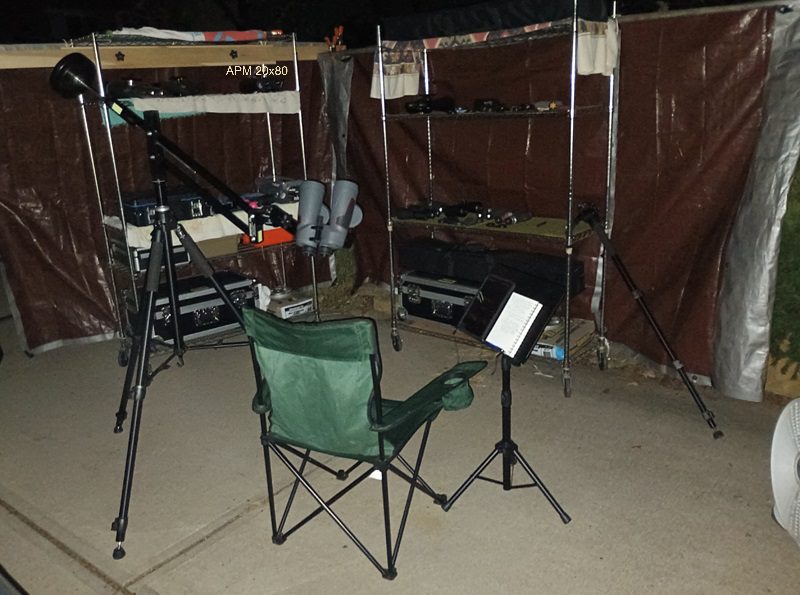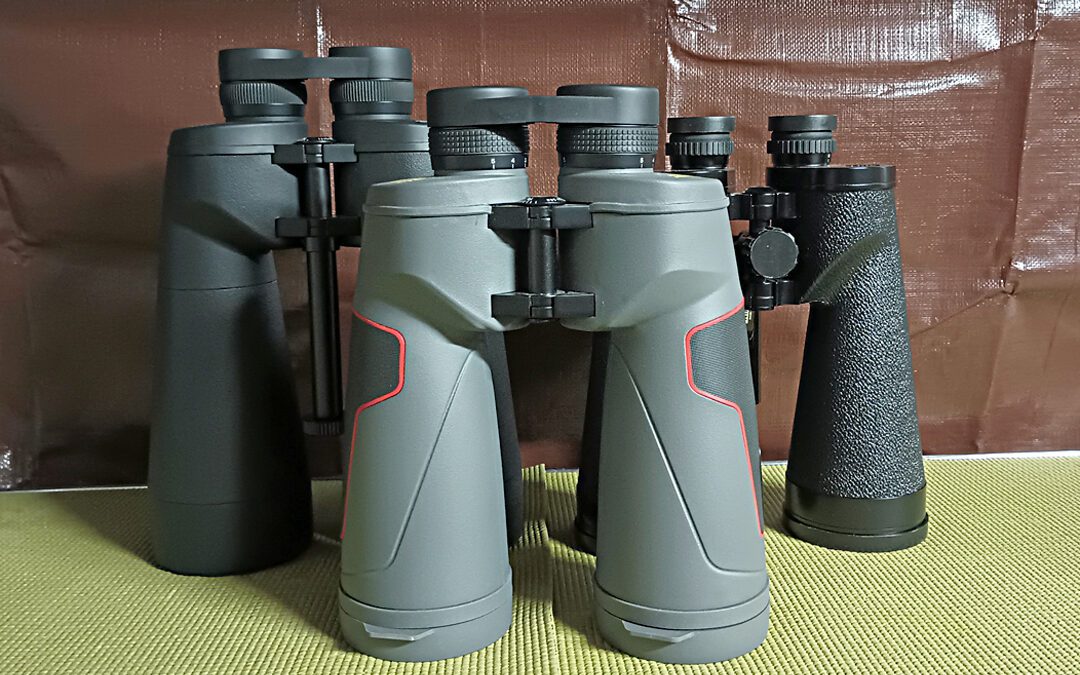On wednesday evening, September 20, 2023, among other binocular astronomy adventures I observed a hexagonal asterism pointed out by fellow Cloudy Nights member aznuge with an APM 20×80 binocular I had been using to log Cygni 100 list doubles (back left in image). After enjoying the view, I wandered north to have a peek at f1 Cygni, aka STF 2743, which is a challenging Cygni 100 double star. What makes it difficult is that the primary is almost five magnitudes brighter than the secondary component, which is only 21 arc-seconds from the primary (4.74/9.43 sep 21″). Somewhat to my surprise, I could not resolve the secondary with the APM 20×80.
The Oberwerk 20×70 ED Ultra (center front in image) had been waiting impatiently on the sideline (a shelf on one of my rolling light shields) for a chance to show it could go the distance (which according to stelledoppie is 1,418.25 light years in the case of STF 2743). And sure enough, the secondary component was cleanly resolved with the 20×70 EDU. It was also resolved with another recent darling, the Nikon 18×70 IF WP (back right in image), but not quite so well as with the Oberwerk, thanks to the slightly smaller exit pupil and the additional 2x of magnification. Larger exit pupils tend to accentuate aberrations ahem in our own eyes and can cause problems resolving challenging double stars.
The APM does have its strengths. The additional aperture gives the views a bit more zing and it goes a bit deeper. It also has better edge performance, though the difference is not consequential for normal viewing because the 20X70 EDU edge performance is still quite good and not distracting. The difference between the two instruments in this regard is only apparent when one is staring at the edge of the field fretting about edge performance. 😉
BUT, the APM 20×80 star shapes are not ideal and have a tendency to spikiness. It doesn’t spoil the views, but it is problematic for observing double stars like STF 2743. The 20×70 ED Ultra star shapes are cleaner with no or minimal spikes on brighter stars.
Owning four 20x binoculars (OB 20×80 Deluxe III, 20×65 ED, 20×70 ED Ultra, and APM 20×80 ED MS) not to mention the Nikon 18×70 IF WP, enables me to evaluate them over time, in many observing sessions on a variety of objects to better understand the strengths of each instrument. And share points of comparison like this observation.

The above image of the f1 and f2 Cygni starfield is from SIMBAD (DSS colored). The bright orange star on the left (west) is f2 Cygni and the bright bluish white star on the right (east) is f1 Cygni. A dark nebula can be seen, west and south (below) of f1 Cygni and to the east of the variable star V2140 Cygni (the bright star on the far right) the “bright” reflection nebula IC 5076 is obvious. Neither can be observed visually from my urban yard. And while IC 5076 is commonly included in star atlases ( for example in the Sky Atlas 2000, the Uranometria 2000, even the Sky and Telescope Pocket Sky Atlas) it is rarely mentioned by visual observers — nothing, for example, in the comprehensive Night Sky Observers Guide. It is more frequently a subject for astro-imaging, any number of fine images of it can be found with a quick web search. The color contrast between f2 and f1 Cygni is readily seen and enjoyable with 10x binoculars. To the east of f2 Cygni is the double star STTA 215 (far left in image). Here are my observation notes of this Cygni 100 list double from Friday, 11 August 2023.
STTA 215
21h10m +4741′
AC 6.55/7.52 sep 136.7″ pa 189
Non-physical
Distance: 2407.41 / 1107.98
Spectral Type: B6IV / M5III
Color Index: -0.02 blue-white / +1.39 orange-red
Nikon 18×70 / Friday 11 August 2023 / urban sky
Light blue primary with apricot secondary at a generous distance. Both stars bright, but the primary is brighter. A pleasing spectacle. Should be easy with mounted 10×50 binoculars.
And here is the 20×70 ED Ultra, in its glory, while the APM sulks on the sideline. 😊



I haven’t logged onto EtNS in a while since other astro pursuits have had me separated from my beloved binos (aka – refractor fear), but I was more than delighted to jump back into the binocular side of the hobby after gaining a new-to-me celestial weapon from the classifieds: an amazing 20x70ED Ultra!! So needless to say I’m digging this article.
While I own a variety of straight through binoculars ranging from 6.5×32 to 25×100, my favorite have always been 15×70. Slowly working my way up the great ziggurat of 70mm binos, I started the hobby with a humble 15×70 SkyMaster before discovering Oberwerk and upgrading to their Deluxe series and later to the Ultra, which I consider the essence of what I wanted out of a binocular that I’d use as my primary two-eyed instrument.
Although I was very interested in the reports of the 20x70EDU, I was worried that I wouldn’t like the smaller 3.5mm exit pupil or smaller 3.5°TFOV compared to my 15x70U, which is 4.6mm & 4.4°TFOV. I also didn’t think the FK61 ED element in the objectives would make much of a difference. Plus they were quite a bit more expensive than what I already had, which was already near the top of my budget… I used all of that to justify my decision of holding off on one until I found a used pair in great shape for a price I couldn’t ignore 😆
I’ve had the 20x70EDU for about 3 weeks now and have spent many nights and lots of observing hours with it so far, and I’m absolutely loving it!! I still haven’t had a full night out with it next to the 15x70U so I’ll hold off on any comparison between the two, but so far it’s the most comfortable high mag bino I’ve used hands down. I’m not sure if it’s the 70°AFOV or the eye relief or what, but it matches up great to my eyes and face fantastically. It’s excellent correction shows beautiful colors and good CA control along with little glare or ghosting on targets I’ve used it on. The background sky is a beautiful black with lots of contrast. The 20x magnification is great and even allows me to see both equatorial bands on Jupiter and to separate the rings of Saturn from the disk, both things I struggle with my larger aperture instruments (admittedly this isn’t something binos are usually tested on). This may be the best double star bino I’ve ever used, especially on beautifully colored close doubles! I thought I’d miss the aperture from my larger binos when viewing DSOs, but truth be told they do better than my 80’s with a more pleasing image and are extremely more versatile than my 100’s. About the only thing that I think the bino does lack is edge performance which isn’t something that bothers me in an astro binocular anyhow, so is of little concern during use.
So long story short: these 20x70ED Ultra’s are fantastic!! Instead of working my way through the Oberwerk product line, I probably should’ve just listened to the advice of trying this bino to start with, although I would’ve missed out on the first hand learning experience all those different optics gave me.
Now my mind keeps going back to my choice of handheld binos, recommendations for the 8x42ED Sport, and my reluctance to get an “ugly” roof prism bino…. 😂
Congratulations on adding a 20×70 ED Ultra to your binocular collection, astro. And for getting a great buy. Well done! 😁I was comparing the 20×70 with other 20x binoculars in my collection a few weeks ago, and was reminded again of how outstanding it is — optically, mechanically, and ergonomically. It’s an easy binocular to love. 🥰